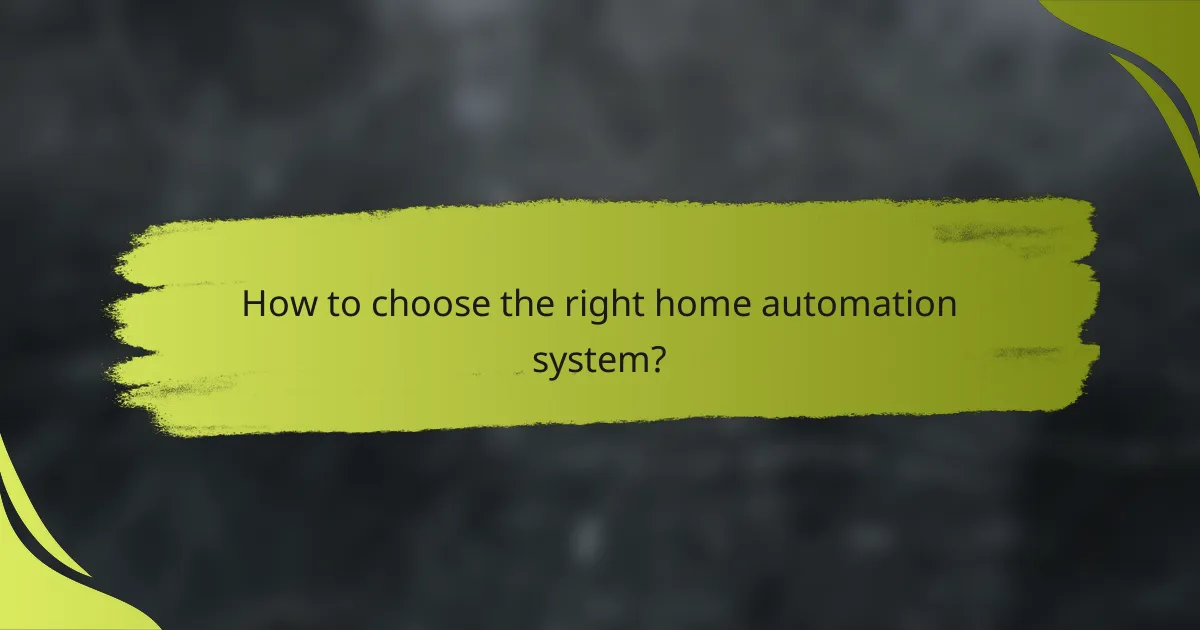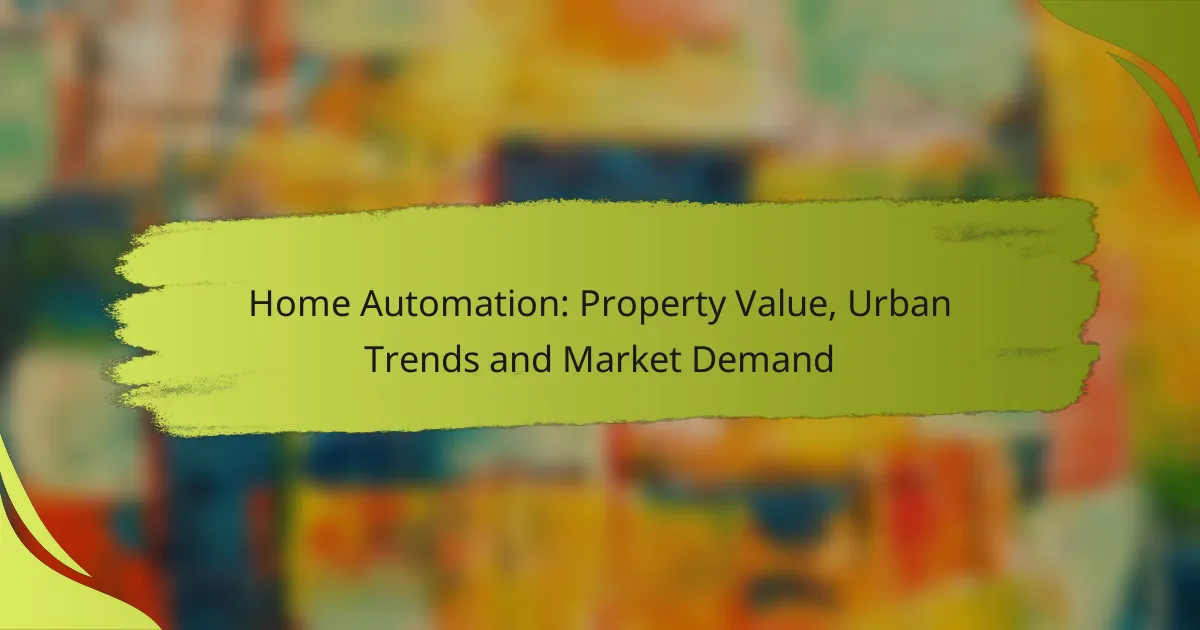Home automation is transforming the real estate landscape in India by significantly boosting property values through the integration of smart technologies that enhance convenience, security, and efficiency. As urban populations expand and consumer preferences shift towards modern living solutions, the demand for automated homes is surging, making these properties more attractive to potential buyers.

How does home automation impact property value in India?
Home automation can significantly enhance property value in India by integrating smart technologies that improve convenience, security, and efficiency. As more homeowners seek modern living solutions, properties equipped with automation features tend to attract higher offers and faster sales.
Increased resale value
Properties with home automation systems often see an increase in resale value, sometimes ranging from 10% to 20% compared to similar homes without such features. Buyers are willing to pay a premium for homes that offer smart lighting, security systems, and climate control.
Investing in home automation not only enhances the living experience but also positions the property favorably in a competitive market. Features like automated blinds or smart thermostats can be appealing selling points during property viewings.
Attracts tech-savvy buyers
Home automation is particularly attractive to tech-savvy buyers who prioritize modern conveniences and energy efficiency. These buyers often look for homes that can integrate with their existing devices, such as smartphones and tablets, providing seamless control over their living environment.
Marketing a property with smart home features can help target this demographic effectively. Highlighting compatibility with popular platforms like Google Home or Amazon Alexa can further enhance appeal.
Enhances energy efficiency
Home automation systems can lead to significant energy savings, which is a key consideration for many buyers. Smart thermostats, for example, can optimize heating and cooling schedules, potentially reducing energy bills by 10% to 30%.
Additionally, automated lighting systems can ensure that lights are only on when needed, further contributing to energy efficiency. This not only benefits the environment but also makes the property more attractive to buyers concerned about sustainability.

What are the urban trends in home automation in Indian cities?
Urban trends in home automation in Indian cities are characterized by increasing adoption of smart technologies, driven by the need for enhanced convenience, security, and energy efficiency. As urban populations grow, the integration of automation systems into homes is becoming essential for modern living.
Smart city initiatives
Smart city initiatives in India aim to improve urban living through technology, focusing on sustainable development and efficient resource management. Cities like Bengaluru and Pune are implementing projects that incorporate smart grids, intelligent transportation systems, and automated waste management, which often include home automation components.
These initiatives encourage homeowners to adopt smart technologies, as they align with government goals for energy conservation and improved urban infrastructure. Residents can benefit from incentives, such as reduced energy bills and enhanced property values, by participating in these programs.
Integration with public infrastructure
Home automation systems are increasingly being integrated with public infrastructure, enhancing overall urban functionality. For instance, smart homes can connect with municipal services to manage energy consumption, water usage, and security systems more effectively.
This integration allows homeowners to receive real-time data about their energy usage and local environmental conditions, promoting more informed decisions. As cities develop smart grids, residents can expect seamless communication between their home systems and public utilities, leading to greater efficiency.
Growing demand for IoT devices
The demand for Internet of Things (IoT) devices in Indian cities is on the rise, driven by the desire for connected living. Homeowners are increasingly investing in smart appliances, security systems, and energy management tools that can be controlled remotely via smartphones or voice assistants.
As the market for IoT devices expands, prices are becoming more accessible, making it easier for a broader range of consumers to adopt these technologies. Homeowners should consider compatibility and security features when selecting IoT devices to ensure a cohesive and safe smart home environment.

What is the market demand for home automation in India?
The market demand for home automation in India is rapidly growing, driven by technological advancements and changing consumer preferences. As more homeowners seek smart solutions for convenience and security, the adoption of home automation systems is becoming increasingly common.
Rising consumer awareness
Consumer awareness regarding home automation has significantly increased in India, fueled by the proliferation of smart devices and digital marketing. Homeowners are now more informed about the benefits of automation, such as energy efficiency, enhanced security, and improved lifestyle convenience.
Educational campaigns and demonstrations in retail spaces have played a crucial role in this awareness. Many consumers are now actively seeking information on how smart home technologies can enhance their living spaces.
Increased disposable income
As India’s economy continues to grow, many households are experiencing an increase in disposable income. This financial growth allows consumers to invest in home automation systems, which were previously considered luxury items.
With a wider range of products available at varying price points, more families can afford to incorporate smart technologies into their homes. This trend is expected to continue as economic conditions improve and more affordable options become available.
Preference for convenience and security
There is a strong preference among Indian consumers for home automation solutions that offer convenience and security. Features such as remote monitoring, automated lighting, and smart locks are particularly appealing, as they provide peace of mind and ease of use.
Homeowners are increasingly prioritizing systems that integrate seamlessly with their daily routines, allowing them to control various aspects of their homes from their smartphones. This shift towards prioritizing convenience and security is a key driver of the growing market demand for home automation in India.

What are the key features of popular home automation systems?
Popular home automation systems typically include smart lighting, advanced security features, and energy management tools. These systems enhance convenience, security, and efficiency in residential properties, making them increasingly desirable in the real estate market.
Smart lighting solutions
Smart lighting solutions allow homeowners to control their lights remotely via smartphone apps or voice commands. These systems can include features like dimming, color changes, and scheduling, providing flexibility and energy savings.
When choosing smart lighting, consider compatibility with existing fixtures and the ease of installation. Many systems can be integrated with other smart devices, enhancing overall home automation.
Home security systems
Home security systems are designed to protect properties through surveillance cameras, motion detectors, and smart locks. These systems can send alerts to homeowners and allow for remote monitoring, increasing peace of mind.
When selecting a security system, evaluate the types of sensors needed, the quality of video resolution, and the subscription costs for monitoring services. Look for systems that offer integration with other smart home devices for a cohesive security solution.
Energy management tools
Energy management tools help homeowners monitor and control their energy consumption, leading to potential cost savings. These tools can include smart thermostats, energy usage monitors, and automated scheduling for appliances.
Consider systems that provide real-time data and insights into energy usage patterns. Many energy management solutions can be integrated with renewable energy sources, such as solar panels, to optimize efficiency and reduce utility bills.

How to choose the right home automation system?
Choosing the right home automation system involves assessing compatibility with your existing devices, evaluating the user interface for ease of use, and considering installation and maintenance costs. A well-selected system enhances convenience and can increase property value.
Assessing compatibility with existing devices
Compatibility is crucial when selecting a home automation system. Ensure that the system can integrate seamlessly with your current devices, such as smart lights, thermostats, and security cameras. Check for compatibility with popular protocols like Zigbee, Z-Wave, or Wi-Fi.
To evaluate compatibility, create a list of your existing devices and their specifications. Research whether the automation system supports these devices or if additional hubs are required. This step can save you from unexpected expenses and technical issues later on.
Evaluating user interface and ease of use
A user-friendly interface is essential for a successful home automation experience. Look for systems that offer intuitive controls, whether through mobile apps, voice commands, or physical remotes. The easier it is to use, the more likely you are to take full advantage of the system’s features.
Consider testing the interface in-store or through online demos. Pay attention to how quickly you can navigate through settings and control devices. A system that requires extensive training or complex setups may lead to frustration and underutilization.
Considering installation and maintenance costs
Installation and maintenance costs can vary significantly among home automation systems. Some systems are DIY-friendly, allowing you to save on installation fees, while others may require professional installation, which can range from a few hundred to over a thousand USD.
Additionally, factor in ongoing maintenance costs, such as subscription fees for cloud services or software updates. It’s wise to budget for these costs to avoid surprises. A comprehensive cost analysis will help you choose a system that fits your financial situation while meeting your automation needs.
